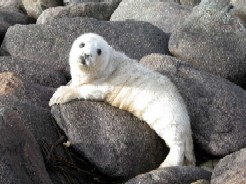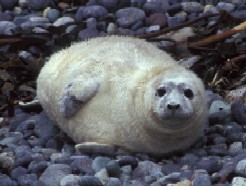The Grey Seal (Halichoerus grypus) is one of two seal species found in Ireland. It is found on both sides of the North Atlantic Ocean although the greatest proportion of the population is found in UK waters. It occurs in greatest numbers on the western seaboard of Ireland although significant numbers also occur on the east and southeast coasts (map of Generalised distribution range postulated for grey seal ![]() [137KB]).
[137KB]).
This seal is quite large with males, or bulls, reaching 2.5–3.3 metres long and weighing up to 300 kilograms; the cows are much smaller, typically 1.6–2.0 metres long and 100–150 kilograms weight. The colour of this species ranges from grey to brown and normally has blotches of lighter or darker fur over its body. The colour of the body tends to be darker over the dorsal (back) than the ventral (belly) surface. The body is streamlined to allow easy swimming and both the fore and hind limbs have been modified into flippers used to propel the seal through the water. These seals, whilst quite large, are very well adapted to swimming and the marine environment. This seal can be distinguished from common (harbour seals) by the parallel arrangement of the nostrils, large dog-like snout and much larger size.
The Grey Seal generally breed in Irish Waters from September to December on remote and generally undisturbed areas, in particular offshore islands. Pups are born with a white coat that they shed before they can take to the water, usually after about six weeks. The mother stays with the pups whilst they remain on the shore. The seals shed their fur during the spring months and remain ashore for the majority of this time. Counts of seals are undertaken during the pupping and moulting period to allow an estimate on the national population to be generated.
 |
 |
| (Photos: NPWS) |
Download SACs designated for Grey Seal ![]() [29KB]
[29KB]
